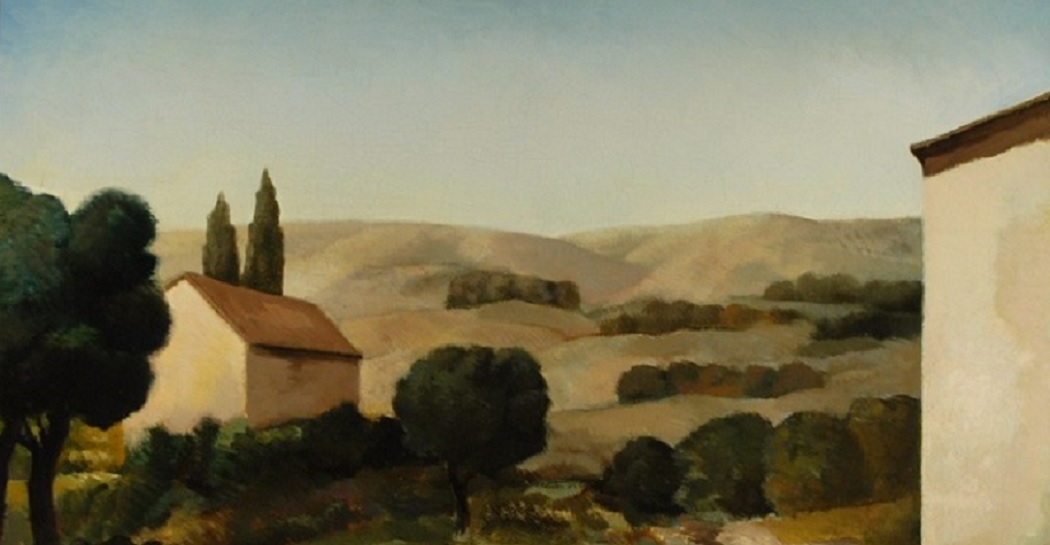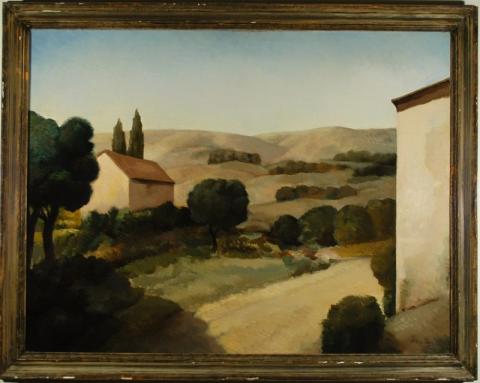The Artwork of the Month - July 2023
Francesco Trombadori,
Paese d’Abruzzo, 1927-1935,
oil on canvas, cm64x83.5,
inv. MSRo 73

In a countryside landscape with low hills scattered with clumps of vegetation, in the foreground is shown, on the right, the corner of a house facing a dirt road, and on the left a second small house surrounded by bushes and trees. Both without windows. A classical, essential and lyrical image, in which soft light, silence and the absence of human activity reign. The delicate and skilful transitions of tone between one area of colour and another make the painting pictorially precious, even if traditional in its figurative choice.
This subject, with minimal variations, returns in other works by the artist, also entitled Paese d'Abruzzo, a region he knew well as he used to spend long periods in Pescasseroli in the early decades of the century. The work is thus part of Trombadori's rich landscape production of the third and fourth decade of the 20th century, which highlights the artist's strong interest in this genre, which was to become even more established in the post-war years. The depiction of variants of the same landscape is usual for Trombadori, who likes to work with photography rather than from life, as his daughter Donatella recalls ("mio padre non ha mai dipinto un paesaggio dal vero", cit. in Fagiolo dell'Arco M., "Alba a Dordrecht", in "Trombadori", Rome, 1986, p. 21). A peculiar way of working, almost theatrical, as if within similar or the same scenarios, the elements of the composition were interchangeable according to the artist's choice: "it can be said that he behaved with landscape as he did with still life: he identified the essential signs and assembled and disassembled them like characters in the limelight of a stage on which the formal delimitation of space is important, as well as the always primary quality of light" (Fagiolo dell'Arco M., ibid., p. 16).
The painting came into the collections of the Museo della Scuola Romana in 2006 thanks to a donation by Donatella Trombadori, the artist's daughter, who had bought it on the antiques market in the late 1980s (oral testimony by Donatella Trombadori).
Francesco Trombadori (Syracuse 1886 - Rome, 1961).
Originally from Siracusa, where he developed a love for painting thanks also to the presence, in the local Santuario di Santa Lucia, of Caravaggio's famous painting dedicated to the burial of the Saint, the artist reached Rome in 1907. In the capital he attended courses at the Accademia di Belle Arti and the Scuola del Nudo. In 1911 he held a first personal exhibition of his paintings, in Syracuse, in the foyer of the Teatro Comunale; during this phase he expressed a painting mostly linked to the current of divisionism, which he had come to know in Rome. In 1914, he was a guest at the 2nd International Exhibition of the Roman Secession where he signed his works with the name Franz Trombadori d'Ortigia. After taking part in the First World War in 1915, where he was wounded, he returned to the capital and joined the Valori Plastici group - founded by the artists Mario and Edita Broglio - and in 1919 took part in the Exhibition of the Society of Amateurs and Culturists. His network of friendships among artists was widespread, also cultivated through his assiduous frequentation of the famous Caffè Aragno on Via del Corso, a meeting place for intellectuals and politicians. He exhibited in 1923 at the Second Roman Biennial, an occasion for comparison with artists with whom he shared a similar neo-classical and purist poetic: from Antonio Donghi to Carlo Socrate and Nino Bertoletti. In 1924 he was invited to the Venice Biennale and to the Exhibition of Twenty Italian Artists at the Pesaro Gallery in Milan. At the Third Biennale in Rome in 1925 he exhibited in the same room as de Chirico, an artist to whom he was bound by a relationship of mutual esteem. In the 1930s his paintings participated in exhibitions organised abroad: Buenos Aires, Stockholm, Oslo, Baltimore. In 1931, he was invited to the first Roman Quadriennale at Palazzo delle Esposizioni. His painting of this era, having abandoned the modes of Divisionism, shows a formal purity combined with a knowledge of the art of the past, offering portraits, nudes and still lifes. He uses a crisp, almost glazed paint style, with a 17th century inspiration in still lifes. The artist is often considered by critics as the interpreter of the new course of return to tradition in Italian painting, and during the 1920s he was included in the Novecento group, promoted by Margherita Sarfatti, the important critic and cultural animator, close to the Regime.
During the last period of the Second World War, Trombadori was involved in a number of dramatic events: from the heavy police interrogation he was subjected to by the Koch Brigade to obtain news of his son Antonello, who was wanted by the SS, to the death of his brother Giuseppe as a result of the suffering he suffered under fascist persecution.
After the Liberation, the first exhibition he took part in was the exhibition Arte Contro la Barbarie, artisti contro l'oppressione nazifascista, organised in August 1944 at the Galleria di Roma by the newspaper l'Unità. He then fully resumed his painting activity in the post-war period, now recognised as a master of Italian painting. We can recall some subsequent personal exhibitions: at the Galleria del Pincio in Rome in 1951, at the Galleria Tartaruga in Rome 1955, at the Centro San Babila in Milan in 1960, at the Galleria Russo in Rome in 1961.
Trombadori was also a militant critic, writing for the magazines 'L'Epoca', 'L'Opinione', 'Il Giornale d'Italia', 'Gente Nostra', 'Il Piccolo' and 'Il Mattino'. He died in Rome in 1961.
In the capital, at Villa Strohl Fern, (currently owned by the French state), on the slopes of Villa Borghese, the studio that the painter, like other artists, had obtained and lived in with his family can be visited, and which has been under the protection of the Ministry of Cultural Heritage and Activities since 1985.
Back to the section > The Artwork of the Month of The Museo della Scuola Romana












































